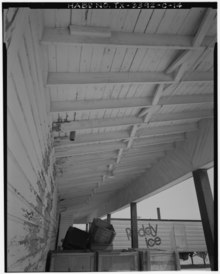Cross bracing

Cross bracing between joists or rafters strengthens the members by preventing sideways deflection. This bracing is known by many names such as herringbone strutting, blocking, bridging, and dwanging.

Cross bracing on a bridge tower
In construction, cross bracing is a system utilized to reinforce building structures in which diagonal supports intersect. Cross bracing can increase a building's capability to withstand seismic activity. Bracing is important in earthquake resistant buildings because it helps keep a structure standing. Cross bracing is usually seen with two diagonal supports placed in an X shaped manner; these support compression and tension forces. Depending on the forces, one brace may be in tension while the other is slack. It helps make buildings sturdier and more likely to withstand lateral forces. Cross bracing can be applied to any rectangular frame structure, such as chairs and bookshelves. In steel construction, steel cables may be used due to their great resistance to tension (although not resistant at all to compression).
The common uses for cross bracing includes bridge (side) supports, along with structural foundations. This method of construction maximizes the weight of the load a structure is able to support. It is a usual application when constructing earthquake-safe buildings.[1]
References
^ Reinforce Building With Cross Bracing, Earthquake Handbook, FEMA Hazard Mitigation Handbook Series, Federal Emergency Management Agency, 2002.